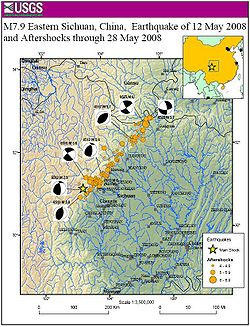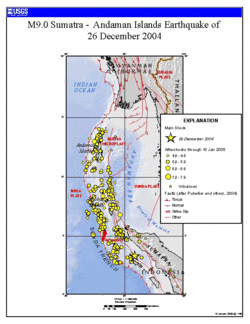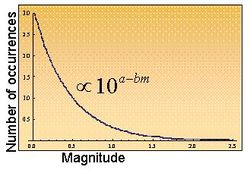Aftershock

An aftershock is a smaller earthquake that occurs after a previous large earthquake in the same area (the main shock). If an aftershock is larger than the main shock, the aftershock is redesignated as the main shock and the original main shock is redesignated as a foreshock. Aftershocks are smaller earthquakes formed as the crust around the displaced fault plane adjusts to the effects of the main shock.
Contents |
Distribution of aftershocks

Most aftershocks are located over the full area of fault rupture and either occur along the fault plane itself or along other faults within the volume affected by the strain associated with the main shock. Typically, aftershocks are found up to a distance equal to the rupture length away from the fault plane.
The pattern of aftershocks helps confirm the size of area that slipped during the main shock. In the case of the 2004 Indian Ocean earthquake and the 2008 Sichuan earthquake the aftershock distribution shows in both cases that the epicenter (where the rupture initiated) lies to one end of the final area of slip, implying strongly asymmetric rupture propagation.
Aftershock size and frequency with time
Aftershocks tend to obey a number of empirical laws concerning magnitude and frequency.
Omori's Law
Aftershocks occur with a pattern that follows Omori's law.[1] Omori's law, or more correctly the modified Omori's law, is an empirical relation for the temporal decay of aftershock rates. In 1894, Fusakichi Omori published his work on the aftershocks of earthquakes, in which he stated that aftershock frequency decreases by roughly the reciprocal of time after the main shock.

where:
- n(t) is the rate of earthquakes measured in a certain time t after the main shock,
- K is the amplitude, and
- c is the "time offset" parameter.
The modified version of Omori's law, now commonly used, was proposed by Utsu in 1961.[2][3]

where
- p modifies the decay rate and typically falls in the range 0.7–1.5.
According to these equations, the rate of aftershocks decreases quickly with time. The rate of aftershocks is proportional to the inverse of time since the mainshock. Thus whatever the odds of an aftershock are on the first day, the second day will have 1/2 the odds of the first day and the tenth day will have approximately 1/10th the odds of the first day (when p is equal to 1). These patterns describe only the mass behavior of aftershocks; the actual times, numbers and locations of the aftershocks are 'random', while tending to follow these patterns. As this is an empirical law values of the parameters are obtained by fitting to data after the mainshock occurred and they have no physical basis/meaning.
Båth's Law

The other main law describing aftershocks is known as Båth's Law[4][5] and this states that the difference in magnitude between a main shock and its largest aftershock is approximately constant, independent of the main shock magnitude, typically 1.1-1.2 on the Moment magnitude scale.
Gutenberg-Richter law
Aftershock sequences also typically follow the Gutenberg-Richter law of scaling, which refers to the relationship between the magnitude and total number of earthquakes in a region in a given time period.

Where:
 is the number of events in a given magnitude range
is the number of events in a given magnitude range is a magnitude minimum
is a magnitude minimum and
and  are constants
are constants
In summary, there are more small aftershocks and fewer large aftershocks.
Impact of aftershocks
Aftershocks are dangerous because they are usually unpredictable, can be of a large magnitude, and can collapse buildings that are damaged from the mainshock. Bigger earthquakes have more and larger aftershocks and the sequences can last for years or even longer especially when a large event occurs in a seismically quiet area; see, for example, the New Madrid Seismic Zone, where events still follow Omori's law from the mainshocks of 1811–1812. An aftershock sequence is deemed to have ended when the rate of seismicity drops back to a background level; i.e., no further decay in the number of events with time can be detected.
Land movement around the New Madrid is reported to be no more than 0.2 millimetres (0.0079 in) a year.[6] in contrast to the San Andreas Fault which averages up to 37 millimetres (1.5 in) a year across California.[7] Aftershocks on the San Andreas are now believed to top out at 10 years while earthquakes in New Madrid are considered aftershocks nearly 200 years after the 1812 New Madrid earthquake.[8]
Foreshocks
Many scientists hope to use foreshocks to predict upcoming earthquakes. In particular, the East Pacific Rise transform faults show foreshock activity before the main seismic event. Reviews of data of past events and their foreshocks showed that they have a low number of aftershocks and high foreshock rates compared to continental strike-slip faults. (McGuire et al., 2005) Most likely different types of faults exhibit different kinds of foreshock activity, possibly quite far from the main shock, and some may present none.
See also
- Earthquake storm
- Earthquake swarm
Notes
- ↑ F. Omori (1894) "On the aftershocks of earthquakes," Journal of the College of Science, Imperial University of Tokyo, vol. 7, pages 111–200.
- ↑ Utsu, T. (1961) "A statistical study of the occurrence of aftershocks," Geophysical Magazine, vol. 30, pages 521–605.
- ↑ Utsu, T., Ogata, Y. ,and Matsu'ura, R.S. (1995) "The centenary of the Omori formula for a decay law of aftershock activity," Journal of Physics of the Earth, vol. 43, pages 1–33.
- ↑ Richter, Charles F., Elementary seismology (San Francisco, California, USA: W. H. Freeman & Co., 1958), page 69.
- ↑ Båth, Markus (1965) "Lateral inhomogeneities in the upper mantle," Tectonophysics, vol. 2, pages 483–514.
- ↑ New Madrid fault system may be shutting down - physorg.com – March 13, 2009
- ↑ Wallace, Robert E.. "Present-Day Crustal Movements and the Mechanics of Cyclic Deformation". The San Andreas Fault System, California. http://education.usgs.gov/california/pp1515/chapter7.html. Retrieved 2007-10-26.
- ↑ "Earthquakes Actually Aftershocks Of 19th Century Quakes; Repercussions Of 1811 And 1812 New Madrid Quakes Continue To Be Felt". Science Daily. http://www.sciencedaily.com/releases/2009/11/091104132652.htm. Retrieved 2009-11-04.
References
- McGuire JJ, Boettcher MS, Jordan TH (2005). "Foreshock sequences and short-term earthquake predictability on East Pacific Rise transform faults". Nature 434 (7032): 445–7. doi:10.1038/nature03377. PMID 15791246.